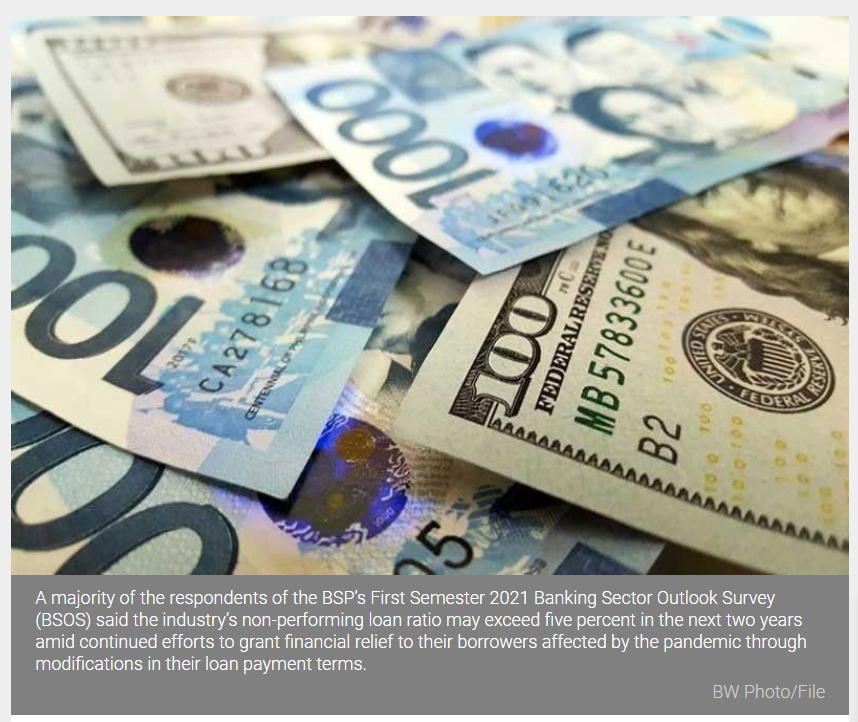Philippines: Big banks see sustained rise in bad loans
MANILA, Philippines — Universal and commercial banks expect bad loans to increase in the next two years as consumer loans remain vulnerable and prone to weakening due to the COVID-19 pandemic, according to the Bangko Sentral ng Pilipinas (BSP).
A majority of the respondents of the BSP’s First Semester 2021 Banking Sector Outlook Survey (BSOS) said the industry’s non-performing loan (NPL) ratio may exceed five percent in the next two years amid continued efforts to grant financial relief to their borrowers affected by the pandemic through modifications in their loan payment terms.
BSP Governor Benjamin Diokno said the banks’ projections are consistent with the NPL estimates of the central bank for 2021.
Diokno said the enactment of Republic Act 11523, or the Financial Institutions Strategic Transfer (FIST) Act, as well as the issuance of its implementing rules and regulations in the first semester would help limit the buildup of NPLs in the financial system.
Based on earlier estimates, the BSP expects banks to sell about P152 billion worth of non-performing assets (NPAs) through the new law, which is expected to reduce the NPL ratio of the banking industry by 0.63 to 0.71 percentage point in the second year of implementation.
Latest data from the BSP showed the gross NPL ratio of Philippine banks rising for the fifth straight month to 4.49 percent in May as the country continues to struggle amid the resurgence of COVID-19 infections.
The latest gross NPL ratio was the highest since the 4.52 percent recorded in September 2008. The ratio was also higher than the 2.43 percent recorded in May last year.
The gross NPL ratio of universal and commercial banks alone climbed for the fifth straight month to 4.01 percent in May from 3.98 percent in April.
The industry’s soured loans, figures showed, jumped by 83 percent to P479.48 billion in May from P262 billion in the same month last year. As a result, the allowance for credit losses surged by 50.4 percent to P383.39 billion from P254.94 billion.
The BSP survey showed 54 percent of the respondents said they intend to report a higher NPL coverage ratio of more than 50 to 100 percent, compared to 44.3 percent in the previous survey, demonstrating a more prudent stance on the part of banks.
In particular, the BSP said 75 percent of universal and commercial banks expect the NPL coverage ratio to range from 76 percent to more than 100 percent.
Furthermore, about 37 percent of responding big banks expect a more conservative restructured loan ratio of one to two percent, while 43.5 percent of thrift, foreign as well as rural and cooperative banks see a higher restructured loan ratio of more than five percent from the previous forecast of three to five percent.
Data showed the banking industry’s restructured loans amounted to P263.51 billion in May or 5.5 times the P48.09 billion booked in the same month last year, translating to a restructured loan ratio of 2.47 percent. Likewise, past due loans, or loans left unsettled beyond payment date, rose by 5.2 percent to P593.35 billion from P563.8 billion for a past due ratio of 5.56 percent.
Despite the bleak outlook for NPLs, Diokno said industry leaders continue to view the outlook of the banking system as stable with expectations of double-digit growth in assets, loans, investments, deposits and net income for the next two years.
“The upbeat expectations of the banking system based on the results of the BSOS for the first semester of 2021 is testament to its confidence in the strong medium-term prospects of the country’s economy,” he said.
Source: https://www.philstar.com/business/2021/07/22/2114112/big-banks-see-sustained-rise-bad-loans


 Thailand
Thailand




